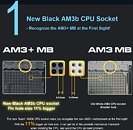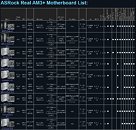- Joined
- Oct 9, 2007
- Messages
- 47,235 (7.55/day)
- Location
- Hyderabad, India
| System Name | RBMK-1000 |
|---|---|
| Processor | AMD Ryzen 7 5700G |
| Motherboard | ASUS ROG Strix B450-E Gaming |
| Cooling | DeepCool Gammax L240 V2 |
| Memory | 2x 8GB G.Skill Sniper X |
| Video Card(s) | Palit GeForce RTX 2080 SUPER GameRock |
| Storage | Western Digital Black NVMe 512GB |
| Display(s) | BenQ 1440p 60 Hz 27-inch |
| Case | Corsair Carbide 100R |
| Audio Device(s) | ASUS SupremeFX S1220A |
| Power Supply | Cooler Master MWE Gold 650W |
| Mouse | ASUS ROG Strix Impact |
| Keyboard | Gamdias Hermes E2 |
| Software | Windows 11 Pro |
ASRock launched a new marketing campaign for its AMD platform motherboards, claiming to be the first manufacturer to be out with motherboards that use real AM3+ sockets. AM3+ is the FCPGA socket that has been designed for upcoming AMD FX series "Zambezi" processors based on the "Bulldozer" architecture. As a part of its campaign, ASRock highlighted the benefits of opting for its AM3+ motherboards. In the process, it ended up disclosing quite some technical information about AM3+, and why AMD designed it in the first place, when apparently AM3 can run Zambezi with a BIOS update.
To begin with, ASRock started with the socket itself, showing that AM3+ sockets can be identified by "AM3b" written on the socket, and have wider pin-holes (0.51 mm vs. 0.45 mm of AM3). It is possible that future (retail?) versions of the CPU, if not the engineering samples doing rounds, could use packages with thicker pins that are incompatible with AM3. The thicker pins add durability, and are designed for a different set of electrical specifications.

As part of those different set of electrical specifications, AM3+ processors are designed to talk to voltage controllers over a different VID, that's 3.4 MHz VID, while AM3 socket can only handle 400 KHz VID. Even if AM3+ chips run on AM3, they might probably lack some power management features, because AM3 boards' controllers might not support them. AM3+ will also feature a more advanced load-line design that lets controllers monitor electrical loads of the CPU and keep voltages within a stable range, minimizing vDroop (lowering of vCore with higher than normal load (when overclocked, loaded), messes up OC stability). AMD's new load-line design increases efficiency by up to 11.8%.


AMD's new electrical specification, coupled with ASRock's implementation are claimed to reduce CPU power electrical noise by up to 22%. This has a direct impact on energy efficiency. Also, there's a reason those pins are thicker: the package is designed to handle 32% higher current than AM3, the AM3+ is designed to handle 145A, while AM3 was designed for 110A.


Lastly, with AM3+, AMD changed the CCR (Combo Cooler Retention Module), that plastic frame around the socket to hold the cooler, to be a two part kit, instead of the single-piece frame since s754. The two-piece CCR design first came to be with s1207, then on to other server sockets, and now makes its entry to the client platform with AM3+. The two-piece design ensures that air blown downwards by top-flow coolers make it to the VRM circuitry, with no plastic bars obstructing it. ASRock listed out specifications of all its AM3+ motherboards. They're based on AMD 8-series chipsets.


View at TechPowerUp Main Site
To begin with, ASRock started with the socket itself, showing that AM3+ sockets can be identified by "AM3b" written on the socket, and have wider pin-holes (0.51 mm vs. 0.45 mm of AM3). It is possible that future (retail?) versions of the CPU, if not the engineering samples doing rounds, could use packages with thicker pins that are incompatible with AM3. The thicker pins add durability, and are designed for a different set of electrical specifications.

As part of those different set of electrical specifications, AM3+ processors are designed to talk to voltage controllers over a different VID, that's 3.4 MHz VID, while AM3 socket can only handle 400 KHz VID. Even if AM3+ chips run on AM3, they might probably lack some power management features, because AM3 boards' controllers might not support them. AM3+ will also feature a more advanced load-line design that lets controllers monitor electrical loads of the CPU and keep voltages within a stable range, minimizing vDroop (lowering of vCore with higher than normal load (when overclocked, loaded), messes up OC stability). AMD's new load-line design increases efficiency by up to 11.8%.


AMD's new electrical specification, coupled with ASRock's implementation are claimed to reduce CPU power electrical noise by up to 22%. This has a direct impact on energy efficiency. Also, there's a reason those pins are thicker: the package is designed to handle 32% higher current than AM3, the AM3+ is designed to handle 145A, while AM3 was designed for 110A.


Lastly, with AM3+, AMD changed the CCR (Combo Cooler Retention Module), that plastic frame around the socket to hold the cooler, to be a two part kit, instead of the single-piece frame since s754. The two-piece CCR design first came to be with s1207, then on to other server sockets, and now makes its entry to the client platform with AM3+. The two-piece design ensures that air blown downwards by top-flow coolers make it to the VRM circuitry, with no plastic bars obstructing it. ASRock listed out specifications of all its AM3+ motherboards. They're based on AMD 8-series chipsets.


View at TechPowerUp Main Site







 Your not the one I was responding too, but this is a tech forum, a lot here try and keep up on current hardware, but unless people are planning an upgrade, they don't really read about hardware that isn't on the market yet. I personally want to move to a 990FX, but theres been news leaked on it for the last year, I just can't find a good reason to keep reading that stuff for so long, I usually start doing my research about a month before the products hit the shelves and decide if I really want it. Like the 890FX, I wanted to get a Crosshair IV badly, but when I was able to get 3.9ghz out of my 1055t, I couldn't really justify it.
Your not the one I was responding too, but this is a tech forum, a lot here try and keep up on current hardware, but unless people are planning an upgrade, they don't really read about hardware that isn't on the market yet. I personally want to move to a 990FX, but theres been news leaked on it for the last year, I just can't find a good reason to keep reading that stuff for so long, I usually start doing my research about a month before the products hit the shelves and decide if I really want it. Like the 890FX, I wanted to get a Crosshair IV badly, but when I was able to get 3.9ghz out of my 1055t, I couldn't really justify it.

 Yuck
Yuck 
 And it goes "VRRROOOOOOMMMMM!!".
And it goes "VRRROOOOOOMMMMM!!". 